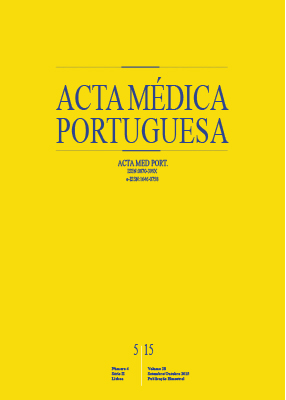Mediterranean Spotted Fever: Retrospective Review of Hospitalized Cases and Predictive Factors of Severe Disease
DOI:
https://doi.org/10.20344/amp.5992Keywords:
Boutonneuse Fever, Prognosis, Rickettsia conorii, Rickettsia Infections, Risk Factors.Abstract
Introduction: Mediterranean spotted fever, an ancient zoonotic disease raising current issues. This study aims to reevaluate the disease clinical picture and to identify prognostic factors related to severe disease.Material and Methods: We evaluate cases admitted to a central hospital during 12-year period. The risk factors were determined by uni and multivariate analysis, comparing patients admitted in general infirmary versus intermediate/intensive care units or in case of death.
Results: We reviewed 71 cases of Mediterranean spotted fever. The mean age was 63.3 ± 16.7 years and 52.1% were male. The eschar was observed in 62.0%. Fever and rash were the most common clinical findings. Forty five percent of patients developed complications and 22.5% were admitted to intermediate and/or intensive care units. Apyrexia, dyspnea, renal failure and elevated lactic dehydrogenase levels at admission were predictors of severe disease development (p < 0.034). Alcoholism was related with prolonged hospitalization (p = 0.020). Absence of fever (p = 0.019) and elevated serum creatinine levels (p = 0.028) were identified as independent factors associated with severe outcome. The mortality rate was 2.8%.
Discussion: Although Mediterranean spotted fever is usually assumed to be benign, severe cases are emerging.
Conclusion: Early identification of the infection and continuous patient surveillance are crucial, particularly in those with greater risk of developing severe or fatal disease.
Downloads
Downloads
Published
How to Cite
Issue
Section
License
All the articles published in the AMP are open access and comply with the requirements of funding agencies or academic institutions. The AMP is governed by the terms of the Creative Commons ‘Attribution – Non-Commercial Use - (CC-BY-NC)’ license, regarding the use by third parties.
It is the author’s responsibility to obtain approval for the reproduction of figures, tables, etc. from other publications.
Upon acceptance of an article for publication, the authors will be asked to complete the ICMJE “Copyright Liability and Copyright Sharing Statement “(http://www.actamedicaportuguesa.com/info/AMP-NormasPublicacao.pdf) and the “Declaration of Potential Conflicts of Interest” (http:// www.icmje.org/conflicts-of-interest). An e-mail will be sent to the corresponding author to acknowledge receipt of the manuscript.
After publication, the authors are authorised to make their articles available in repositories of their institutions of origin, as long as they always mention where they were published and according to the Creative Commons license.









